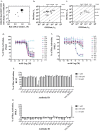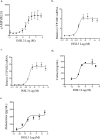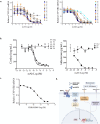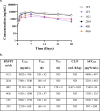Discovery of RXFP2 genetic association in resistant hypertensive men and RXFP2 antagonists for the treatment of resistant hypertension
- PMID: 38851835
- PMCID: PMC11162469
- DOI: 10.1038/s41598-024-62804-7
Discovery of RXFP2 genetic association in resistant hypertensive men and RXFP2 antagonists for the treatment of resistant hypertension
Erratum in
-
Author Correction: Discovery of RXFP2 genetic association in resistant hypertensive men and RXFP2 antagonists for the treatment of resistant hypertension.Sci Rep. 2025 Mar 4;15(1):7615. doi: 10.1038/s41598-025-91682-w. Sci Rep. 2025. PMID: 40038481 Free PMC article. No abstract available.
Abstract
Hypertension remains a leading cause of cardiovascular and kidney diseases. Failure to control blood pressure with ≥ 3 medications or control requiring ≥ 4 medications is classified as resistant hypertension (rHTN) and new therapies are needed to reduce the resulting increased risk of morbidity and mortality. Here, we report genetic evidence that relaxin family peptide receptor 2 (RXFP2) is associated with rHTN in men, but not in women. This study shows that adrenal gland gene expression of RXFP2 is increased in men with hypertension and the RXFP2 natural ligand, INSL3, increases adrenal steroidogenesis and corticosteroid secretion in human adrenal cells. To address the hypothesis that RXFP2 activation is an important mechanism in rHTN, we discovered and characterized small molecule and monoclonal antibody (mAb) blockers of RXFP2. The novel chemical entities and mAbs show potent, selective inhibition of RXFP2 and reduce aldosterone and cortisol synthesis and release. The RXFP2 mAbs have suitable rat pharmacokinetic profiles to evaluate the role of RXFP2 in the development and maintenance of rHTN. Overall, we identified RXFP2 activity as a potential new mechanism in rHTN and discovered RXFP2 antagonists for the future interrogation of RXFP2 in cardiovascular and renal diseases.
© 2024. The Author(s).
Conflict of interest statement
C.G.S., S.D., L.S., N.P., K.A., A.C.H., A.W., J.M., N.P.B., A.Y.C., J.M.D., A.J.C., C.V.T., A.E.T., H.O., J.F., C.K., J.K., G.K., F.W., A.P.M. are employees of GSK and hold stock in the company. S-S.Z., L.L., A.H.C., X.W., Y.W., J.P., P.K., D.F., S.J.P. are employees of 23andMe and hold stock in the company. All research funding was provided by GSK and 23andMe. The authors declare no non-financial competing interests.
Figures






Similar articles
-
Prolonged RXFP1 and RXFP2 signaling can be explained by poor internalization and a lack of beta-arrestin recruitment.Am J Physiol Cell Physiol. 2009 May;296(5):C1058-66. doi: 10.1152/ajpcell.00581.2008. Epub 2009 Mar 11. Am J Physiol Cell Physiol. 2009. PMID: 19279230
-
Relaxin family peptide receptors Rxfp1 and Rxfp2: mapping of the mRNA and protein distribution in the reproductive tract of the male rat.Reprod Biol Endocrinol. 2007 Jul 10;5:29. doi: 10.1186/1477-7827-5-29. Reprod Biol Endocrinol. 2007. PMID: 17623071 Free PMC article.
-
The different ligand-binding modes of relaxin family peptide receptors RXFP1 and RXFP2.Mol Endocrinol. 2012 Nov;26(11):1896-906. doi: 10.1210/me.2012-1188. Epub 2012 Sep 12. Mol Endocrinol. 2012. PMID: 22973049 Free PMC article.
-
Relaxin family peptide receptors--from orphans to therapeutic targets.Drug Discov Today. 2008 Aug;13(15-16):640-51. doi: 10.1016/j.drudis.2008.04.002. Epub 2008 Jun 6. Drug Discov Today. 2008. PMID: 18675759 Review.
-
Receptors for relaxin family peptides.Ann N Y Acad Sci. 2005 May;1041:61-76. doi: 10.1196/annals.1282.010. Ann N Y Acad Sci. 2005. PMID: 15956688 Review.
Cited by
-
Identification of potential drug targets and possible drugs for esophageal carcinoma from genetic insights: a comprehensive two-sample Mendelian randomization study.Discov Oncol. 2025 Aug 25;16(1):1621. doi: 10.1007/s12672-025-02777-9. Discov Oncol. 2025. PMID: 40853405 Free PMC article.
References
-
- Tsao, C. W. et al. Heart disease and stroke statistics—2023 update: A report from the American Heart Association. Circulation147, e93–e621 (2023). - PubMed
-
- United States Renal Data System. 2022 USRDS Annual Data Report: Epidemiology of kidney disease in the United States. https://usrds-adr.niddk.nih.gov/2022/chronic-kidney-disease (2022). - PMC - PubMed
-
- Remuzzi, G., Ruggenenti, P. & Perico, N. Chronic renal diseases: Renoprotective benefits of renin-angiotensin system inhibition. Ann. Intern. Med.136, 604–615 (2002). - PubMed
MeSH terms
Substances
LinkOut - more resources
Full Text Sources
Medical

